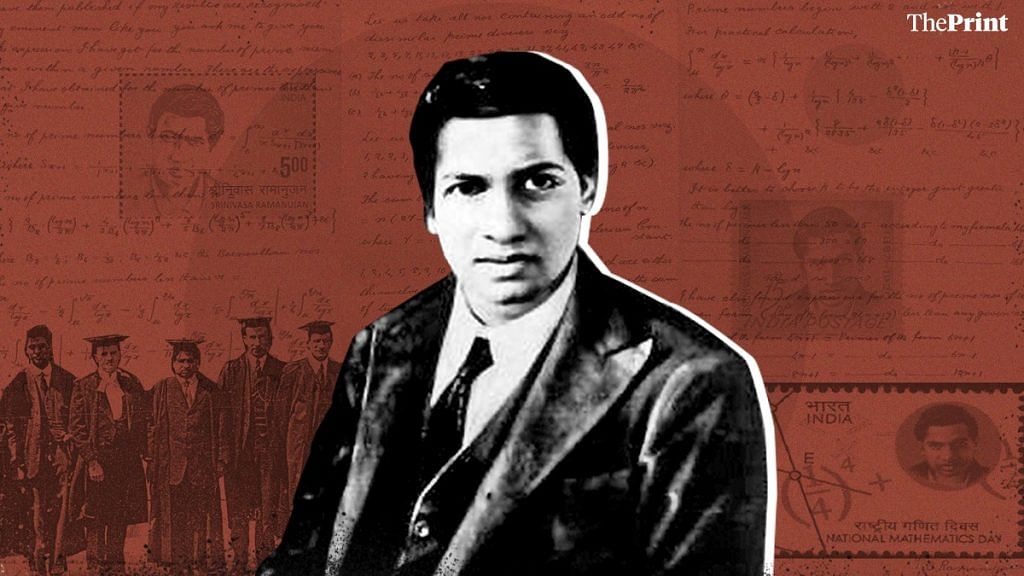Bengaluru: During the time Srinivasa Ramanujan was trying to prove his mettle as a mathematician, there was a phase when people struggled to decide whether he was a “real genius or a crank”.
When he presented his ideas to Indian Mathematical Society founder member Ramachandra Rao in the early years of the 20th century, the latter noted that he saw “quite at once that there was something out of the way; but my knowledge did not permit me to judge whether he talked sense or nonsense”.
But it wasn’t long before Ramanujan had put all doubts to rest. By the time he died at the age of 32, the genius of this self-taught mathematician was a subject of global renown, drawing parallels with the greats of the field from centuries past.
Today, his birth anniversary on 22 December is celebrated as National Mathematics Day in India — a tip of the hat to the achievements of a legendary mathematician whose short but spectacular life continues to evoke awe 100 years since his death, inspiring at least two movies over the past decade.
Also read: Birthday tribute to CP Ramanujam, India’s other great mathematician who also died young
A genius is born
Ramanujan was born in the small town of Erode in Tamil Nadu (then Madras Presidency) on 22 December 1887, to a store clerk and a temple singer. He grew up in a small house at Kumbakonam that is today a museum in his honour.
Ramanujan displayed advanced mathematical cognition as a child. Before he was a teenager, he had exhausted college-level mathematics courses. His affinity for the subject reached a new depth at the age of 15, when he came across mathematician G.S. Carr’s 1886 book Synopsis of Elementary Results in Pure and Applied Mathematics, which contained 6,000 theorems and their proofs. Ramanujan verified the theorems listed by Carr in the book and started to develop his own theorems at home.
He also independently studied other mathematical concepts like the Bernoulli rational numbers when he was still in school.
In 1904, at the age of 17, he joined the Government Arts College in Kumbakonam. Because he devoted all his energy to mathematics, he could not graduate other courses and dropped out of college. Pursuing independent research in mathematics, with no formal training and working as a clerk, Ramanujan spent his late teens in extreme poverty, often with less than enough to eat.
In 1910, the 23-year-old newly-married Ramanujan met the founder and secretary of the Indian Mathematical Society, V. Ramaswamy Aiyer, who introduced him to mathematical circles in the country. What followed was a stint as researcher at University of Madras.
Also read: Behind the scientific brilliance of Ramanujan & Salam lay religious inspiration
Work and legacy
In 1913, Ramanujan mailed a manuscript of his independently developed mathematical theorems to renowned Cambridge mathematician G.H. Hardy, who immediately recognised the advanced and complex nature of the unknown man’s work.
Along with the support of famed mathematicians J.E. Littlewood and Gilbert Walker, Hardy convinced Ramanujan to enrol at Trinity College in Cambridge, UK. Here, he collaborated with Hardy and Littlewood for five years, while also independently working on his own research. He was often compared to the great 19th-century German mathematician Carl Gustav Jacobi, who made groundbreaking advancements in mathematics.
He obtained a Bachelor of Arts by Research degree in March 1916 for his work on highly composite numbers. He made monumental contributions to the fields of elliptic functions, number theory, mathematical analysis, infinite series, continued fractions, and theta functions.
He was subsequently elected to the London Mathematical Society and became one of the youngest Fellows of the Royal Society. He was also the first Indian Fellow of Trinity College.
Illness and death
Ramanujan was plagued by illnesses through most of his life, primarily driven by malnutrition. During his growing years in India, Ramanujan grew up in a poor family. Later, when he was a struggling independent researcher away from home, he often went to bed hungry.
After moving to Cambridge, he struggled as a vegetarian in England — a situation worsened by rationing during the First World War from 1914-18. Additionally, the English weather didn’t sit well with Ramanujan, who was born and raised in the tropical climes of Tamil Nadu.
Ramanujan had already struggled to get operated for hydrocele testis (accumulation of fluid in a testicle) while in India. He had also suffered from bouts of dysentery. In Cambridge, his health started to deteriorate in 1917, and he was diagnosed with a severe vitamin deficiency. He was admitted to multiple hospitals and sanatoria for chronic illness, before recovering just enough to board a ship to Bombay in 1919.
Upon arrival in India, his condition worsened and he became emaciated. He was diagnosed with tuberculosis and gastric ulcers. He suffered from severe pulmonary damage, likely from hepatic amoebiasis. Ramanujan died in April 1920 at Kumbakonam.
Also read: P.C. Mahalanobis: The father of Indian statistics who introduced concept of planned economy
